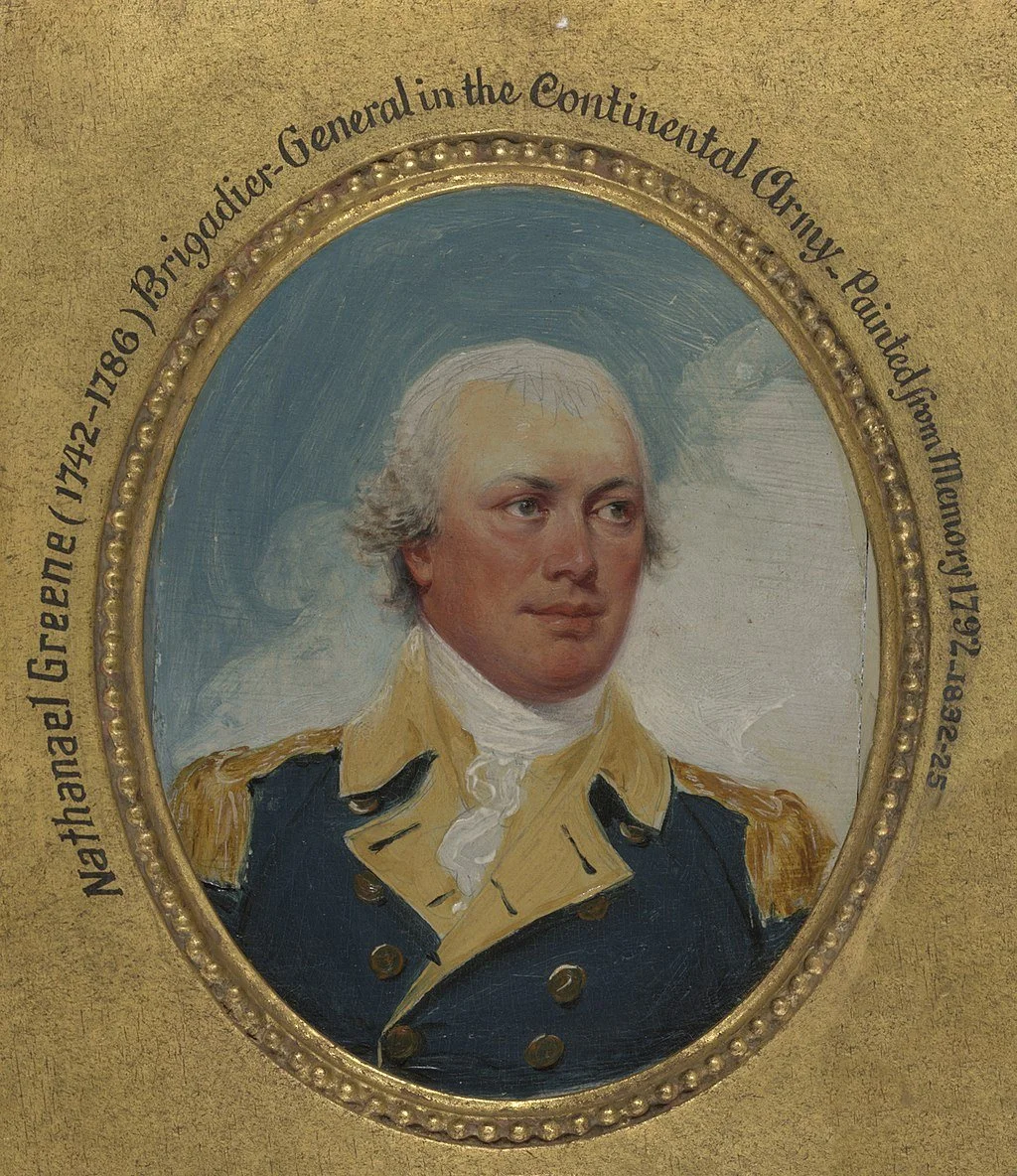The Siege of Ninety Six was a siege in South Carolina in the American Revolutionary War from May to June 1781. The Patriot Nathanael Greene led a force of 1,000 in a siege against Loyalists in Ninety Six. The siege took place around Star Fort. Abrielle M. Lamb explains.
Nathaniel Greene. By John Trumbull, 1792.
Patriots and Loyalists
During the American Revolution, there were two major groups that emerged in the colonies concerning war efforts and conflicting sentiments towards England. Many are familiar with the patriots, the revolutionists who dumped tea in the harbor and challenged the authority of the King. However, there were a number of individuals and communities in the colonies who did not align with the patriot movement or desire independence from the crown; these groups were known as loyalists. Loyalists supported the English Monarchy in retaining power over the colonies and a continuation of their reign in America. In the struggle between patriots and loyalists there was a significant landmark that is less discussed compared to larger memorials or battle sites but, nonetheless, should be remembered. A major loyalist community during the American Revolutionary Era was Ninety Six in South Carolina. There had been a considerable amount of tension in this area before and during the Revolution between patriots and loyalists; however, it was the loyalists who had control of this area. Star Fort shielded the settlement of Ninety Six, according to The American Battlefield Trust, “Ninety Six was protected by the formidable Star Fort and the smaller Stockade Fort. Its garrison was made up almost entirely of loyalist colonists.”[1]
Star Fort
The Star Fort would prove to be a truly significant location during the American Revolution, specifically during the siege of Ninety Six in the latter half of the war. Star Fort was designed, as its name suggests, in the shape of a star which differed from the common square fort layout at that time. The fort was set into the ground, making the walls thick mounds of earth. The construction of the fort lasted from December of 1780 to early 1781. The star shaped design was not a common or largely desirable layout as capacity for soldiers was greatly reduced, and the design was more difficult to construct than the average square forts. However, loyalist engineer, Lt. Henry Haldane was convinced that the unique shape with its eight points would be more beneficial in the long run. The benefit that Haldane saw in the design was that the points of the star made it possible for musket and cannon fire to cover all sides and shoot in every direction from the fort's walls.[2] Though it was constructed using an uncommon design, it proved a strong front for the British Army and loyalist forces.
Nathanael Greene and His Siege
The patriot revolutionist, Nathanael Greene, launched a famous attack known as the Siege of Ninety Six which took place from May 22 – June 18, 1781. On June 18, Greene issued an attack on the fort, while at the same time, British troops were traveling from Charleston to Ninety Six to support and defend their forts. It was with some hesitation that Greene gave the order, but he did order the attack on Star Fort. The battle lasted for just under an hour in which time Greene’s men valiantly attempted to take the fort from the loyalists but were inevitably forced to retreat. The incoming British troops from Charleston arrived two days after Greene’s army withdrew from the area. The loyalists had indeed held their ground but after the siege British officers concluded that their position was too vulnerable and abandoned their post.[3] There are several reasons that the Star Fort was significant during the American Revolution, two of the main points of its importance rests in Greene’s attack and Britian's inevitable abandonment of the fort. Greene’s attack on the fort was important because although Greene had to retreat while the loyalists held their position at Ninety Six, he had launched a daring attack. Greene’s continued fighting and strategy in North and South Carolina during the war greatly contributed to American independence.[4] The impact that Green’s siege had on the British was significant. When they abandoned the fort, they destroyed what was left after the siege and burned the buildings that remained. The war continued and there were other battles fought in the southern colonies but the British departure from the fort effectively brought an end to the British occupation at Ninety Six.[5] Though Greene did not take Star Fort during his siege, he showed his strength and the courage of his men; and although the British Army held Star Fort, they were ultimately forced to abandon their position.
The Star Fort Today
Today, visitors can walk out to the Star Fort and battlefield which has undergone very little reconstruction since its original construction. The National Park Service comments, “The siege trenches are partially reconstructed, but the Star Fort is original. The Star Fort was an earthen fort. As you see it today is how it looked in 1781... The walls are a little weatherworn in places, but are original.”[6] There are many benefits to visiting physical locations for research and learning. Visiting Star Fort would be helpful for anyone studying the American Revolution to be able to gain a better understanding of how the fighting took place and to see the impressive star shaped fort that had such a large impact on the southern battles, fighting, and strategy during the war for independence.
Did you find that piece interesting? If so, join us for free by clicking here.
Bibliography
“Ninety Six.” American Battlefield Trust. Last modified October 5, 2022. https://www.battlefields.org/learn/articles/ninety-six.
“The Star Fort.” National Parks Service. U.S. Department of the Interior. Last modified August 30, 2024. https://www.nps.gov/nisi/learn/historyculture/the-star-fort.htm.
Cann, Marvin L. “War in the Backcounty: The Siege of Ninety Six, May 22-June 19, 1781.” The South Carolina Historical Magazine 71, no. 1 (January 1971): 1–14.
Fore, Samuel K, and Walter B Edgar. “NINETY SIX, BATTLES OF (1775, 1781).” Essay. In 101 People & Places That Shaped the American Revolution in South Carolina, 103–105. Columbia, SC: University of South Carolina Press, 2021.
“Star Fort Image - Online Tour Stop 11.” National Parks Service. U.S. Department of the Interior, n.d. Accessed October 20, 2025. https://www.nps.gov/nisi/learn/photosmultimedia/online-tour-stop-11.htm.
[1] “Ninety Six.” American Battlefield Trust. Last modified October 5, 2022.
[2] “The Star Fort.” National Parks Service. U.S. Department of the Interior. Last modified August 30, 2024.
[3] Samuel K. Fore and Walter B Edgar. “NINETY SIX, BATTLES OF (1775, 1781).” Essay. In 101 People & Places That Shaped the American Revolution in South Carolina, 103–105. Columbia, SC: University of South Carolina Press, 2021.
[4] “Ninety Six.” American Battlefield Trust. Last modified October 5, 2022.
[5] Samuel K. Fore and Walter B Edgar. “NINETY SIX, BATTLES OF (1775, 1781).” Essay. In 101 People & Places That Shaped the American Revolution in South Carolina, 103–105. Columbia, SC: University of South Carolina Press, 2021.
[6] “The Star Fort.” National Parks Service. U.S. Department of the Interior. Last modified August 30, 2024.







